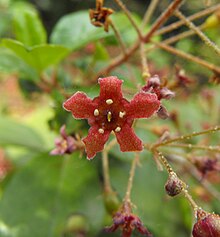Ribes viburnifolium
| Ribes viburnifolium | |
|---|---|

| |
| Scientific classification | |
| Kingdom: | Plantae |
| Clade: | Tracheophytes |
| Clade: | Angiosperms |
| Clade: | Eudicots |
| Order: | Saxifragales |
| Family: | Grossulariaceae |
| Genus: | Ribes |
| Species: | R. viburnifolium
|
| Binomial name | |
| Ribes viburnifolium Gray 1882
| |
Ribes viburnifolium, is an uncommon North American species in the gooseberry family. It is known by the common names Catalina currant, Santa Catalina Island currant, island gooseberry[2] and evergreen currant.[3]
Description
[edit]Ribes viburnifolium is a perennial shrub[4] which grows low to the ground, extending long reddish stems horizontally. The leaves are dark green and shiny on their top surfaces, and lighter green or yellowish and leathery on the undersides. The leaves have glands which exude a sticky, citrus-scented sap.[3][5]
Clusters of deep red flowers bloom in late winter and into early spring. The plant yields small red fruits later in the spring.[5][3] The red fruit attracts birds. The flowers attract hummingbirds and insects.[6]
Distribution and habitat
[edit]Distribution
[edit]Ribes viburnifolium is native to the coast of Baja California and Southern California, from Smuggler's Canyon in the Tijuana Hills of San Diego County[7] to El Rosario in central Baja California.[8] The probable type locality is near Ensenada, from a 1882 collection by Marcus E. Jones.[9] R. viburnifolium is also present on several islands in the region, including Catalina Island and Todos Santos in the Southern California Bight, and Cedros Island farther to the south off of the Vizcaino Peninsula.[8] A persistent population from a planting exists in San Clemente Canyon, San Diego County.[10]
Habitat
[edit]The mainland habitat of Ribes viburnifolium along the southern San Diego and northern Baja California coast consists of coastal sage scrub and coastal succulent scrub,[8] with plants growing in canyons and arroyos with partial shade near the coast.[11] On the Punta Banda, R. viburnifolium is found growing in moist, wind-swept, and foggy sage scrub and chaparral.[7] On Cedros Island, this species is found in the pine groves north of the Gran Cañón.[12]
Cultivation
[edit]'Evergreen currant' has become a popular plant in drought-tolerant gardens.[5]
References
[edit]- ^ "NatureServe Explorer 2.0".
- ^ "Ribes viburnifolium: A. Gray, Catalina currant, Island gooseberry, Santa catalina island currant". Calflora taxon report. Berkeley, CA: University of California.
- ^ a b c Flora of North America, Ribes viburnifolium A. Gray, 1882. Evergreen or Catalina currant
- ^ "Lady Bird Johnson Wildflower Center - The University of Texas at Austin". www.wildflower.org. Retrieved 2022-01-02.
- ^ a b c Casebeer, M. (2004). Discover California Shrubs. Hooker Press: Sonora, California. ISBN 0-9665463-1-8
- ^ "Catalina Currant, Ribes viburnifolium". calscape.org. Retrieved 2022-01-02.
- ^ a b Reiser, Craig H. (July 2001). Rare Plants of San Diego County (PDF). Aquafir Press. pp. 216–217. ASIN B0006F4BAY. Archived from the original (PDF) on 25 May 2022.
- ^ a b c Rebman, Jon P.; Gibson, Judy; Rich, Karen (15 November 2016). "Annotated Checklist of the Vascular Plants of Baja California, Mexico" (PDF). Proceedings of the San Diego Society of Natural History. 45. San Diego Natural History Museum: 178 – via San Diego Plant Atlas.
- ^ Jones, Marcus E. (10 April 1882). "UC372607". CCH2. Consortium of California Herbaria. Retrieved 5 September 2022.
- ^ Beauchamp, R. Mitchel (1986). A Flora of San Diego County, California. National City, California: Sweetwater River Press. p. 170. ISBN 0-931950-01-5.
- ^ Wiggins, Ira L. (1980). Flora of Baja California. Stanford, Calif.: Stanford University Press. p. 641. ISBN 0-8047-1016-3. OCLC 6284257.
- ^ Oberbauer, Thomas A. (1987). Hochberg (ed.). "Floristic Analysis of Vegetation Communities on Isla de Cedros, Baja California, Mexico". Third California Islands Symposium: Recent Advances in Research on the California Islands. Santa Barbara Museum of Natural History, Santa Barbara, CA.: 115–131.
External links
[edit]
- NatureServe imperiled species
- Ribes
- Flora of California
- Flora of Baja California
- Natural history of the California chaparral and woodlands
- Natural history of the Channel Islands of California
- Natural history of the Peninsular Ranges
- Plants described in 1882
- Taxa named by Asa Gray
- Drought-tolerant plants
- Garden plants of North America
- Saxifragales stubs

